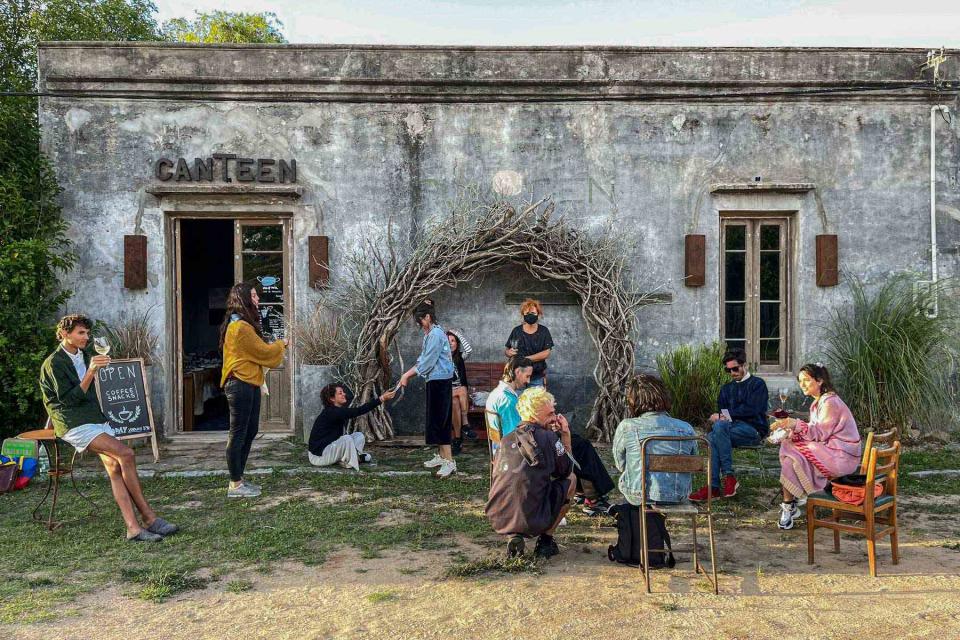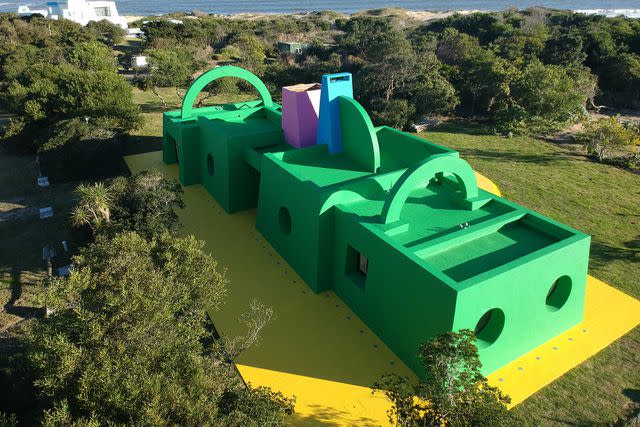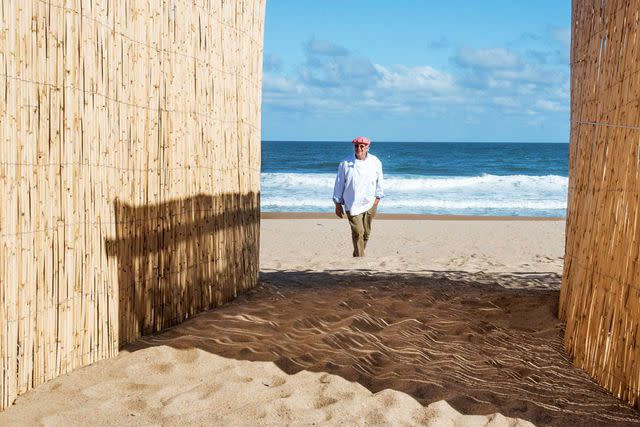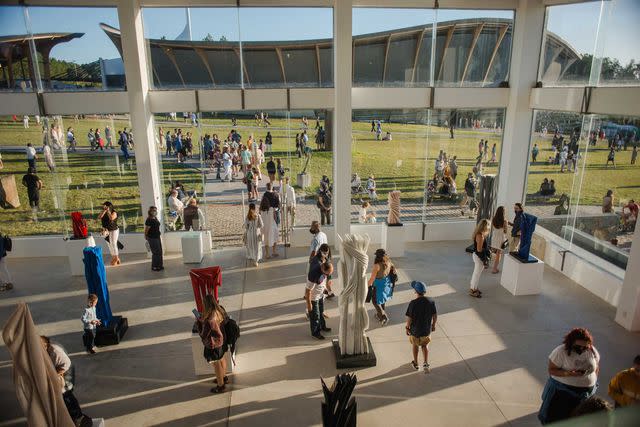This Coastline in South America Is Home to the 'Hamptons of South America,' Art Galleries, and Celebrity-chef Dining
Creative institutions are popping up along the sunny shores of Uruguay, reshaping rural towns into world-class cultural outposts.

Courtesy of CAMPO
Campo Canteen, a café in Pueblo Garzón where visitors can meet resident artists.Insects hummed and frogs croaked as I sat on a granite bench inside a small, dome-roofed structure in the Uruguayan beach town of José Ignacio. It was a muggy day in late January, and my partner, Felipe, and I were staring at the tangerine sunset through a hole in the snow-white marble ceiling of "Ta Khut," South America’s first freestanding Skyspace installation by American artist James Turrell. Artificial light in the structure’s interior fluctuates with the natural fade of dawn and dusk, lulling visitors into an almost meditative state of mind.
Thirty or so of us had gathered that evening, and all were transfixed by the shades that appeared — dandelion and violet one minute, black and lavender the next. Soft flashes of heat lightning crackled through the open roof as the world outside became darker and the Skyspace glowed ever brighter. After 40 minutes, we emerged from our colorful cocoon into the inky night in a complete daze. The other several dozen artworks dotted around our 17-room hotel, Posada Ayana, would have to wait until tomorrow.
Convincing Felipe to come with me to Uruguay’s Atlantic coast for a culture-fueled long weekend hadn’t been easy. The deputy director of an art museum in Santiago, Chile, he had associated the region with its main hub, Punta del Este — a kind of flashy wannabe Miami, where Brazilian models, Argentine soccer players, and Chilean reality stars go to be photographed by paparazzi. In other words, not a destination for an aesthete like him.

Courtesy of Fundación Ama Amoedo
Casa Neptuna, home of the Fundación Ama Amoedo Artistic Residency, in José Ignacio.The crowd on the flight to Punta kept him dubious, but as the day progressed, Felipe began to come around. For lunch, we stopped in the low-key resort town of La Barra, about six miles east of Punta, to eat at Café El Tesoro, a restaurant that shares space with the concept store 3 Mundos. We dined on globally inspired dishes — tuna tartare with turmeric tostadas and a rich burrata salad with pistachio pesto — surrounded by an eclectic collection of art books, blown glass, and ceramics. Later that evening, after our time in the Skyspace, we could both agree on one thing: whatever Punta’s reputation might be, the towns to the east of it are carving out a more international creative scene with serious potential.
The once-humble fishing village of José Ignacio, about 40 minutes east of Punta, is at the epicenter of this transition. In recent decades, it’s blossomed into a tony beachfront enclave filled with galleries, including the new ceramics studio of Argentine sculptor Marcela Jacob; boutiques like the octagonal temple of books Rizoma; and statement architecture, including Edgardo Giménez’s cartoonish Casa Neptuna, which recently began housing the art residency of Fundación Ama Amoedo, where creatives with Latin American backgrounds gather for research and experimentation.
José Ignacio has a reputation for being the Hamptons of South America, but that belies its playful nature. Yes, the homes here cost several million dollars, but most lie on dirt roads. And, unlike much of the Hamptons, the foliage hasn’t been manicured to boring perfection; it’s still wild and spirited — kind of like the place itself.
Residents often credit Francis Mallmann for setting the tone. The eccentric, fire-loving Argentine chef put this place on the map back in 1978 when he opened Posada del Mar, a restaurant at the far end of the José Ignacio lagoon. In late 2020, he returned to a very different José Ignacio to debut Chiringuito Francis Mallmann, a beachfront spot Felipe and I visited on our second day.

Mauricio Rodriguez
Chef Francis Mallmann at Chiringuito, his casual restaurant in José Ignacio.Part of the Costa Garzón development, which will add a boutique hotel in 2024, the restaurant is a high-end twist on South America’s informal seaside stalls. “It’s a place where you can eat and drink on the beach with no shoes on, then relax and go for a swim,” said Mallmann, who happened to be on site.
Felipe and I did just that — feasting on a rib eye with chimichurri cooked a la plancha. The next day, we decamped from José Ignacio for Luz Culinary Wine Lodge. The minimalist six-suite hotel, which opened last November on a 35-acre estate filled with vineyards and olive trees, was conveniently located along the road to Pueblo Garzón, our next stop.
If José Ignacio is the Hamptons of the Southern Hemisphere, then Pueblo Garzón, a half-hour inland and surrounded by pastures, may well be its Marfa. A railway line that once breathed life into the town closed in the 1960s, sending the population plummeting from around 2,000 to the 200 it stands at today. Yet the town never lost its storybook charm. Over the past decade, many of the abandoned homes have been snatched up by artists and turned into galleries.
“When I first visited in 2009, I felt like I’d found a secret place nobody else knew about,” recalled American photographer Heidi Lender, who opened the creative institute Campo in 2017. “It just had this quirky, off-the-beaten-path landscape that’s perfect for any artist.”
At Campo’s Canteen, a space where you can chat with resident artists, we learned about the annual Campo Artfest that has helped put Pueblo Garzón on the map. Each December, more than three dozen artists transform the town, including its old train station and palm-shaded plaza, into a playground of creativity. More permanent galleries are opening, too; during a stroll, we counted a dozen, two of which had just arrived just a month earlier.

Lorena Larriestra y Nicolás Vidal/Courtesy of MACA
The new Museo de Arte Contemporáneo Atchugarry, in Punta del Este.The first, Walden Naturae, is an ambitious outpost of the Buenos Aires contemporary art space Waldengallery. Sequestered behind an imposing brick-red wall, it shows works by regional heavy hitters, including hallucinatory erotic photography by the late Argentine conceptual artist Oscar Bony. The other, La Galerilla, pays homage to the town’s glory days, equipping emerging artists with repurposed freight-train cars to house site-specific installations, like the whimsical, bestiary-inspired collage art of Brazil’s Loló Bonfanti.
On our final day, we traveled back toward Punta del Este to visit the Museo de Arte Contemporáneo Atchugarry, Uruguay’s first major contemporary art museum. Set in a 99-acre sculpture park, it opened in January with a series of 27 hypnotic heliographic prints by León Ferrari, as well as a major retrospective of environmental installation artists Christo and Jeanne-Claude — the scope and scale of which impressed Felipe.
The permanent collection, which pairs Uruguayan masters such as María Freire (a leading figure in the Concrete Art movement) and Joaquín Torres-García (the pioneer of Latin American Constructivism) with global icons like Frank Stella and Peter Halley, lies in a windowless, black-walled gallery on the lower level. “I call it ‘the catacomb’ because it’s very dark,” Uruguayan sculptor Pablo Atchugarry, whose foundation runs the museum, explained. “The artworks appear like a piece of theater, like actors suddenly emerging on a stage.”
MACA, more than anything else, has helped position the region just east of Punta del Este as a bona fide art destination. Of course, visitors will keep flocking to this stretch of Uruguayan coast for sugary sands, seafront feasts, and, yes, celebrity spotting. “The hope is that now,” Atchugarry said, “they’ll see that it has a beating heart of culture, too.”
A version of this story first appeared in the October 2022 issue of Travel + Leisure under the headline "The Art of Transportation."
For more Travel & Leisure news, make sure to sign up for our newsletter!
Read the original article on Travel & Leisure.